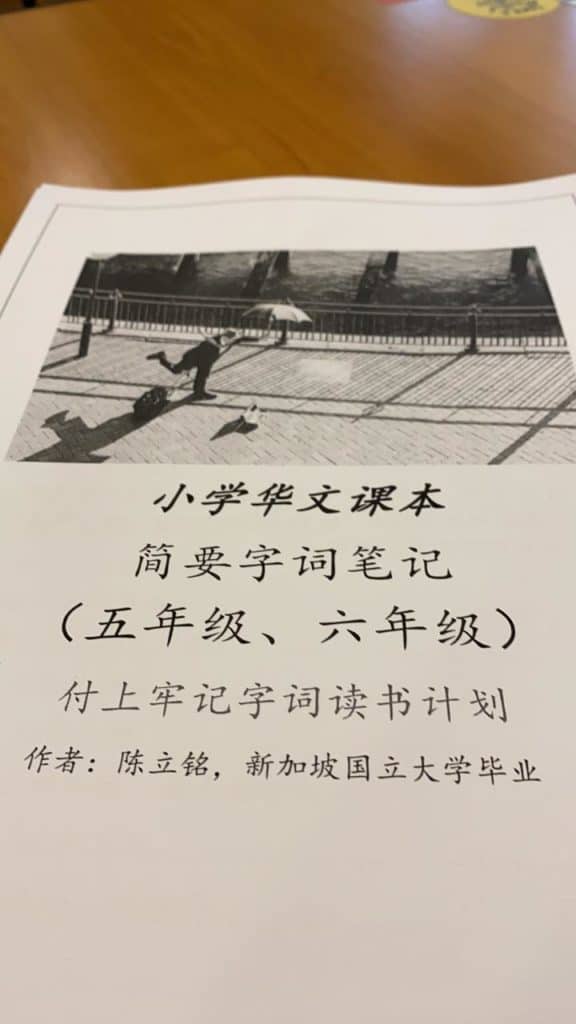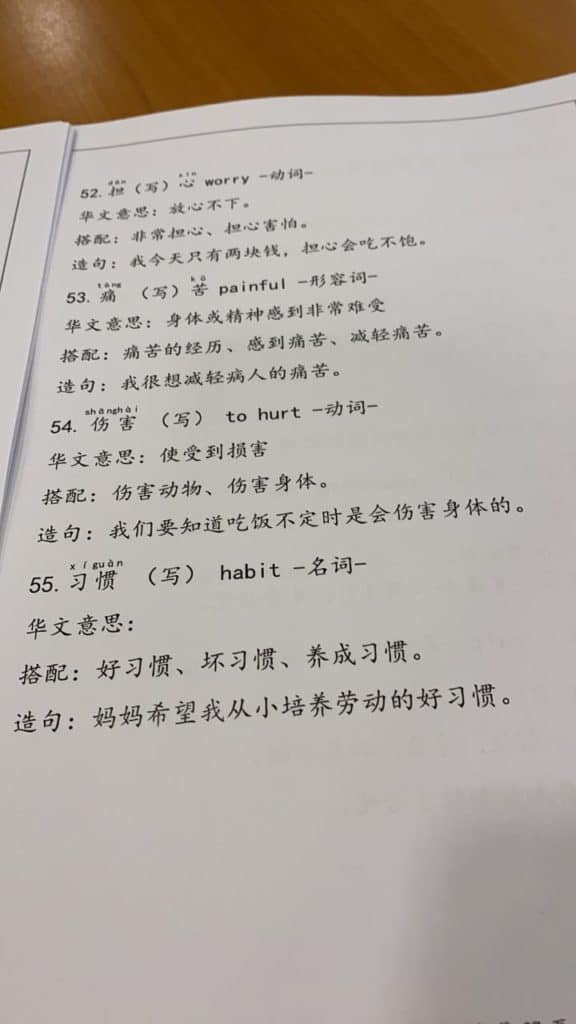Foreword
I had a handful of students who followed the learning method outlined here for at least 1-2 years and they earned themself a pass in PSLE Chinese even though they had Failed their Chinese Language since primary 3 to 5. So passing your PSLE Chinese is A choice, any student can choose to fail and so the student can choose to pass it. PASSING PSLE CHINESE IS A CHOICE.
Role of the teacher/Parent involved
The role of the teacher or parent is to set a goal for the student and ask the student to study daily for 30 minutes to1.5 hours. Remember that the student must study something everyday and remind them to study every day on the dot. Help the student to build a habit of consistent studying.
Students must KNOW that to achieve the GRADE is their responsibility, Not that of their teachers or parents. They have to work towards their goal and achieve their goal, nobody can walk the path for them.
the consequences of not studying Chinese is very clear, the potential grade overall will drop by up to 3 grades.
eg, child have al1 for EL, Math and SCI, and AL8 for CL, then he will get AL11. however if the child worked daily, he may pass Chinese with AL6, making the AL overage grade be 9 which will help him get into a better school. so passing the Chinese paper do provide 2-3 grades improvement.
Step 1 Paper 2 Section A score 50/50
This part is All about vocabulary and the fastest way to build vocabulary is not spelling, not remembering everything or study ALL the vocabulary + not forgetting them. The above method will not work for normal students.
The best way according to my experience in teaching my students is actually to for the student to choose a fixed timing everyday, and sit down in the same place to study just 3-5 words well. Yes 3-5 words, the student need to study them with understanding is more memorable than studying 10-200 words in s short span of time. Why3-5 words, because most students will not find them a hustle to study and it will take off a lot of burden for the student.
Next after you studied the words, you need to use your own words to write down the hanyu pinyin, meaning, word-pair and a simple sentence for each word. (You can always find a word list or spelling list or ‘word’ list to study but those list are complex (Too many things to digest) or too simple (only the characters are listed), or too little information ( no word-pair, no sentences etc) or too much inoformation ( includes character-formed nouns, many situations of a character/nouns/meanings etc.
After trying lots of word lists, I developed my own word list, just enough to study smart and quick to understand. I tested all the words on that list with my students from 2018 to 2023 to make sure they can understand the words on their own. Yes the meanings are simplified and linked to the textbook context for easier studying. I updated the word list to the new textbook “huan le huo ban” in 2019.
Lots of parents and students have reflected that my word list benefits them a lot.
“I bought your P5 and 6 word list.. very helpful.. my daughter who failed in P4 managed to pass her vocabulary mcq section after using it to study for her WA.. got 20/30.”
Shirley Tan
“Dear Mr Tan,
I honestly didn’t expect to receive such good materials! We are lucky to have you to help our children in Chinese!
Thank you once again!”
Winnie Lee
Below are the word lists I’ve created for PSLE Chinese:-


three features of my word list is,
1) every word has a hanyu pinyin and a easy-to-remember meaning plus comtextual word-pair and contextual sentence.
2)every word is numbered so that it is easier to study them, just use the serial numbers.
3) Primary 5 and 6 is enough to handle the vocabulary needs in PSLE Chinese Language.
Step 2 Paper 1 picture composition score 32/40
The 3 Keys to writing Good composition is Theme, storyline and vocabulary.
Theme: The theme is the central idea or message of the composition. Every picture composition requires the student to first come out with the theme for all the 6 pictures and the whole composition should revolve around the theme of the composition.
Storyline: The storyline, or plot, is the sequence of events that make up your story. It includes the introduction, develop, climax, and resolution. A well-structured storyline keeps the reader engaged and makes the composition coherent and compelling.
Vocabulary: A rich vocabulary allows you to express your thoughts and ideas clearly and effectively. It also helps to create vivid imagery and evoke emotions in the reader.
Step 3 Paper 3 Oral recitation and Conversation 40/50
There are 4 things to excel for Oral.
- Recitation: This involves the ability to clearly and accurately deliver information. Practice is key here. Rehearse your presentation multiple times to ensure smooth delivery. Pay attention to your pronunciation, intonation, and pace. Remember, it’s not just about what you say, but also how you say it.
- Topic Memory: Being well-prepared and knowledgeable about your topic is crucial. Understand the subject matter thoroughly and anticipate possible questions. Use techniques like mind mapping or the method of loci to help remember key points. The more familiar you are with your topic, the more confident you’ll be during your presentation.
- Mastery of Vocabulary: A rich vocabulary allows you to express your thoughts more effectively and persuasively. It also helps you adapt your language to different contexts and audiences. Read widely and take note of new words and phrases. Practice using them in sentences to understand their usage.
- Courage to Speak: Public speaking can be daunting, but with practice, you can overcome your fear. Start by speaking in front of a mirror, then to a small group, and gradually increase the audience size. Remember, everyone makes mistakes. Don’t let fear of making a mistake stop you from speaking. Believe in yourself and your ability to communicate effectively.
Step 4 Paper 2 Section B Comprehension 25/40
The key skills in comprehension is 5 things:
- Reading Comprehension: This is the ability to understand and interpret what you’re reading. To improve this skill, practice active reading by taking notes, highlighting key points, and summarizing paragraphs in your own words.
- Critical Thinking: This involves analyzing the text and making inferences or deductions. Ask questions like “Why did the author use this word?” or “What is the implication of this statement?” This helps you to understand the underlying themes and messages.
- Vocabulary: A strong vocabulary is crucial for comprehension. If you come across a word you don’t know, try to understand it from the context. Later, look up its meaning and usage. Regularly learning new words will gradually expand your vocabulary.
- Time Management: Comprehension exams often require you to read and answer questions within a certain time limit. Practice reading quickly and efficiently, and allocate enough time to answer all the questions.
Question mastery: most questions in the PSLE examinations are not random. they are set from easy to hard and the higher order thinking questions just needs the student to have some skills in answering them in a certain way.
Step 4A Paper 3 Listening comprehnsion
Listening Comprehension has only one key point, learn to listen to radio, TV, Youtube, sitcom in Chinese and be familiar with the tone and speech.
Conclusion
students need to have a good foundation in Chinese (AKA good command of vocabulary) to pass, and the rest are just more skills to know and then practice and practice.
There is no shortcut, but there are quick fic solutions like memorizing the good words etc. Those fixes do not rise the students’ standard at all. I recommend all the students to really put in effort to improve the vocabulary for yourself before August.